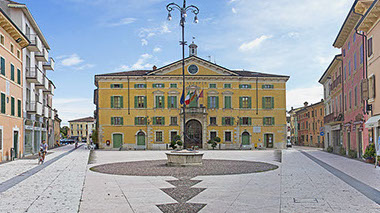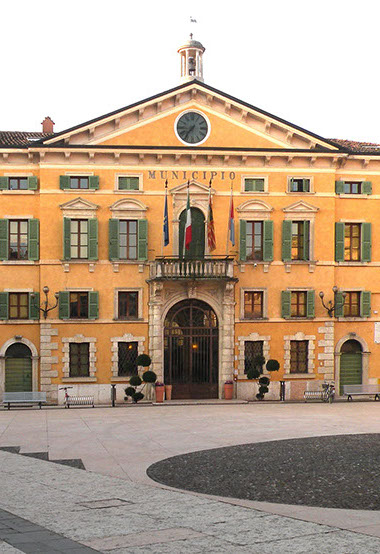Progetto di valorizzazione
del territorio di Valeggio sul Mincio
Palazzo Municipale
XVII SECOLO
Il Palazzo Municipale di Valeggio, completamente restaurato e restituito alla sua originale integrità architettonica nel 1997, è il simbolo della nostra storia civile.
Il Comune di Valeggio affonda le sue origini nell’età medievale, ma la documentazione archivistica a nostra disposizione è piuttosto lacunosa.
Scriveva, sul finire del secolo XIX, lo storico V. Zerbinati: “Valeggio, per la naturale situazione topografica - fra le due fortezze di Mantova e Peschiera, sentinella avanzata di Verona - sostenne più volte la violenza militare in tempi di guerra guerreggiata, specie negli ultimi tre secoli, e il sacco, il fuoco, e il depredamento delle sostanze vi lasciarono tracce indelebili. L’archivio comunale non ne andò esente dalle ingordigie delle briache milizie e le sue carte, i suoi registri e i documenti delle sue proprietà vennero bruciati o dispersi a casaccio”.
Nella seconda metà del Settecento, Valeggio conobbe una straordinaria fase di sviluppo architettonico che delineò la forma urbis del centro storico attuale.
Furono edificati numerosi edifici di particolare rilevanza come le chiese di Valeggio, Borghetto e Salionze; i palazzi Guarienti, Carpani, Foroni, Carteri, Portalupi, ecc. e il Palazzo Municipale che coronò scenograficamente la piazza principale del paese. Ignoto l’architetto cui si deve questo maestoso edificio in stile neoclassico.
Si ipotizza che potrebbe essere stato il veronese Adriano Cristofoli (1718-1788), in quegl’anni impegnato in Valeggio nell’edificazione della chiesa parrocchiale.
La facciata è caratterizzata dal grande portone centrale, fiancheggiato da due colonne bugnate che sorreggono il balcone, e dall’ampio timpano con orologio sormontato da un’edicola marmorea al cui interno una campana batte le ore.
Al piano terra, si apre un vasto atrio decorato con lapidi commemorative.
Al piano nobile, una grande sala consiliare raccoglie sulle pareti i ritratti dei valeggiani che hanno lasciato una traccia nella storia locale.
Al centro della piazza, dedicata al re Carlo Alberto di Savoia (1798-1849), è collocato un settecentesco pozzo marmoreo.
Town Hall
17th CENTURY
The Town Hall of Valeggio, completely restored and returned to its original architectural entirety in 1997, is the symbol of Valeggio's civic history.
The Municipality of Valeggio has its origins in the Middle Ages, but the archive documentation at our disposal is rather incomplete.
One of Valeggio's historians, V. Zerbinati, wrote towards the end of the 19th century:
"Valeggio due to its natural topographical position - in between the two fortresses of Mantua and Peschiera, Verona's advanced sentinel – endured more than once the military violence of the war, particularly in the last three centuries, the plundering the fires, and the pillaging left indelible traces on it. The municipal archive was not exempt from the greed of the militia and its papers, registers, and documents were burnt or randomly scattered”.
During the second half of the 18th century, Valeggio witnessed an extraordinary phase of architectural development which outlined the Forma Urbis of the present historical centre.
Numerous buildings of particular importance were constructed, such as the churches of Valeggio, Borghetto and Salionze; many patricians palaces and this Town Hall, which spectacularly crowns the main square of the town.
The Architect who built this majestic neoclassical building is unknown, he could be the Veronese Adriano Cristofoli (1718-1788), active at that time in the construction of the parish church of Valeggio.
The facade is characterized by the big central front door, flanked by two rusticated columns which support the balcony, and by the ample pediment with clock topped by a bell that strikes the hours.
The vast atrium decorated with commemorative plaques opens on the ground floor.
On the main floor, a big council chamber displays on its walls the portraits of the people of Valeggio who have left a mark on local history.
In front of this palace, in the center of the king Charles Albert of Savoy square, you can see an ancient marble well from the 18th century.
Rathaus
18. Jhr.
Architektonische Route
Das Rathaus von Valeggio erhielt 1997 bei einer völligen Renovierung sein ursprüngliches architektonisches Aussehen zurück. Es ist das Symbol unserer bürgerlichen Geschichte.
Die Gemeinde Valeggio wurde im Mittelalter gegründet. Leider sind die erhaltenen Aufzeichnungen in den Archiven ziemlich lückenhaft. Am Ende des 19. Jahrhundert schrieb der Historiker V. Zerbinati: „Valeggio diente vor allem in den letzten drei Jahrhunderten wegen seiner natürlichen Lage zwischen den beiden Festungen Mantua und Peschiera als Wachposten für Verona bei den militärischen Kämpfen während den Kriegen. Die Belagerung, das Feuer und die Plünderung hinterließen unauslöschbare Spuren. Die gierigen Soldaten plünderten das Gemeindearchiv, verbrannten oder verstreuten Karten, Register und die Dokumente über die Besitztümer“.
In der zweiten Hälfte des 18. Jahrhunderts erfuhr Valeggio eine außerordentliche Phase der architektonischen Entwicklung, die die urbanistische Form der aktuellen Altstadt begrenzte. Es wurden zahlreiche Gebäude von großer Bedeutung errichtet, wie die Kirchen von Valeggio, Borghetto und Salionze, die Paläste Guarienti, Carpani, Foroni, Carteri, Portalupi usw. und das Rathaus, das auf szenographische Weise den Hauptplatz des Ortes krönt.
Der unbekannte Architekt hat dieses majestätische Gebäude im neuklassischen Stil geplant. Man nimmt an, dass es sich dabei um den Veroneser Adriano Cristofoli (1718-1788) handelt, der in jenen Jahren in Valeggio die Pfarrkirche errichtete.
Die Fassade zeichnet sich durch das große mittlere Tor, das seitlich mit zwei versenkte Säulen versehen ist, die den Balkon stützen, und durch den großen Tympanon mit Uhr aus, der von einer marmornen Ädikula überragt wird, in dem die Glocken die Stunden schlagen.
Im Erdgeschoss öffnet sich ein großes Atrium mit Gedenktafeln. Im Zwischengeschoss hängen an den Wänden des großen Ratssaals die Portraits der Valeggianer, die eine Spur in der lokalen Geschichte hinterließen.
In der Mitte des Platzes, der nach König Albert von Savoyen (1798-1849) benannt ist, steht ein marmorner Brunnen aus dem 18. Jahrhundert.

Piazza Carlo Alberto

il Pozzo
© 2019
Comune di Valeggio sul Mincio (VR)
Associazione Percorsi


